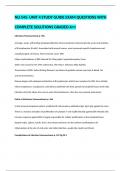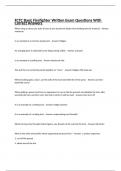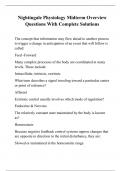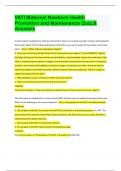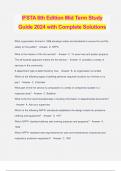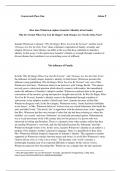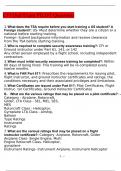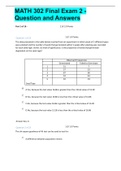COMPLETE SOLUTIONS GRADED A++
Infectious Mononucleosis p. 966
A benign, acute, self-limiting lymphoproliferative clinical syndrome characterized by acute viral infection
of B lymphocytes (B cells). Associated with several tumors, most commonly specific lymphomas and
nasopharyngeal carcinoma. Most common cause- EBV.
Major manifestations of EBV induced IM: Pharyngitis, lymphadenopathy, Fever.
Other viral causes for IM: CMV, adenovirus, HIV, Hep A, Influenza A&B, Rubella.
Transmission of EBV: Saliva (Kissing Disease), secretions of genitalia rectum resp tract & blood. No
aerosol transmission.
Disease begins with widespread infection of B lymphocytes which have receptors for EBV. Virus initially
infects oropharynx, nasopharynx, and salivary epithelial cells then spreads to lymphoid tissue and B cells.
Infection of B cells allows the virus to enter the bloodstream, then the virus spreads systemicaly.
Patho of Infectious Mononucleosis p. 966
In the immunocompetent patient, unaffected B cells produce antibodies (IgG, IgM, IgA) against the virus.
There is a massive activation of proliferation of cytotoxic T cells (CD8) directed against EBV infected cells.
Immune response against EBV is largely responsible for cellular proliferation in the lymphoid tissue
(lymph nodes, spleen, tonsils, liver). Sore throat and fever are the earliest manifestations d/t
inflammation at the site of viral entry and initial infection, usually the mouth and throat.
Complications of infection Mononucleosis p. 967 fig 30.1
,Lymphadenitis
hepatitis
Splenitis
Pneumonitis
Meningitis
Encephalitis
Clinical manifestations of infectious mononucleosis p. 967
Incubation period: 30-50 days (4-8 weeks), then a 3-5 day prodrome of fever, malaise, arthralgias (joint
pain). These symptoms vary in severity for the next 7-20 days.
At time of dx patient has classic triad of symptoms: fever, pharyngitis, lymphadenopathy of cervical
lymph nodes.
Pharyngitis: whitish, greyish green thick exudate.
Severe complications: meningitis, encephalitis, guillain barre syndrome, bells palsy, optic neuritis, mental
impairment, transverse myelitis, cerebellar ataxia, demyelinating disease.
Ocular manifestations: eyelid/periorbital edema, dry eyes, keratitis, uveitis, conjunctivitis, retinitis,
oculoglandular syndrome, choroiditis, papillitis, ophthalmoplegia. In child: Reye syndrome
Pulmonary involvement: RARE- hilar and mediastinal lymphadenopathy, interstitial pneumonitis, pleural
effusions, pneumonia and resp fail in immunocompromised patient.
Older patient with 2 weeks of temp that can't be explained EBV should be suspected
Eval and Tx of infectious mononucleosis p. 967
Children present w/: fever, sore throat, lymphadenitis,
Young adults present w/: malaise, fatigue, lymphadenopathy and fever of unknown origin.
Blood contains increased # of atypical lymphocytes.
,Dx based on Hoagland's criteria: 50% lymphocytes, 10% atypical lymphocytes in the blood with presence
of fever, pharyngitis, adenopathy confirmed by a + serologic test.
Serological test: heterophile antibodies, Monospot test (limited bc CMV, adenovirus, toxoplasmosis also
produce heterophilic antibodies causing false +).
Tx: IM is usually self limiting and intervention is rarely required. Rest & alleviation of symptoms. No ASA
used with child or adolescent d/t reye syndrome.
Pharyngitis of Strep origin tx w/ PCN or erythromycin. NO ampicillin (causes rash in patients with IM)
Avoid strenuous activities. Steroids only with severe complications. Acyclovir with immunocompromised.
Leukemia p. 968
A clonal malignant disorder of leukocytes in the bone marrow and usually but not always of the blood.
Common feature is an uncontrolled proliferation of malignant leukocytes causing an overcrowding of
bone marrow and decreased production of functional normal hematopoietic cells. Thus it has been
termed as an accumulation disorder as well as proliferation disorder.
Acute Leukemia p. 968
Characterized by undifferentiated or immature cells, usually a blast cell, and the onset of disease is
abrupt and rapid with a short survival time.
Chronic Leukemia p. 968
The predominant cell is more differentiated but does not function normally, with a relatively slow
progression
4 types of leukemia p. 968
Acute Lymphocytic (ALL)
Acute Myelogenous (ALM)
, Chronic Lymphocytic (CLL)
Chronic Myelogenous (CML)
Acute Leukemia p. 970
ALL- an aggressive fast growing leukemia with too many lymphoblasts (immature WBC) found in the
blood and bone marrow.
ALM- Aggressive fast growing leukemia with an excessive number of myeloblasts (immature WBC that
are not lymphoblasts) found in bone marrow and blood.
Acute leukemia is a result of B and T cell origin
ALL of B cell origin occurs mainly in children involving the mutation required for B cell development
(ETV6 & RUNX1).
ALL of T cell origin- Mutation in NOTCH1
ALL- defined by > 30% of lymphoblasts in bone marrow or blood
ALM- Epigenome alteration; incidence peaks in 6th decade of life
Clinical Manifestations:
ALL- w/in days to a few weeks stormy onset:
S/S generally the same with all acute leukemias:
Table 30.2
Fatigue from bone marrow depression, bleeding from thombocytopenia, fever from infection. Infection
usually gram-negative bacilli: E Coli, Pseudomonas aeruginosa, Klebsiella pheumoniae.
Liver, spleen and lymph node enlargement more common in ALL
CNS S/S: HA, V, papilledema, facial palsy, blurred vision, auditory disturbances, meningeal irritation
Prophylaxis is key with CNS involvement: radiation/chemo but not needed with ALM bc only 5% of ALM

